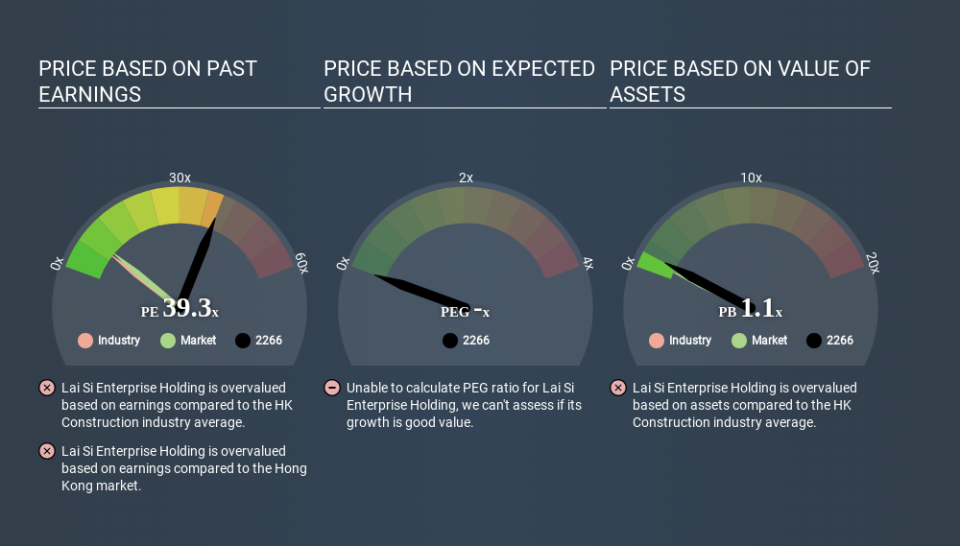Despite Its High P/E Ratio, Is Lai Si Enterprise Holding Limited (HKG:2266) Still Undervalued?

This article is written for those who want to get better at using price to earnings ratios (P/E ratios). We'll apply a basic P/E ratio analysis to Lai Si Enterprise Holding Limited's (HKG:2266), to help you decide if the stock is worth further research. Looking at earnings over the last twelve months, Lai Si Enterprise Holding has a P/E ratio of 39.27. That corresponds to an earnings yield of approximately 2.5%.
Check out our latest analysis for Lai Si Enterprise Holding
How Do I Calculate A Price To Earnings Ratio?
The formula for P/E is:
Price to Earnings Ratio = Share Price (in reporting currency) ÷ Earnings per Share (EPS)
Or for Lai Si Enterprise Holding:
P/E of 39.27 = MOP0.628 ÷ MOP0.016 (Based on the trailing twelve months to December 2019.)
(Note: the above calculation uses the share price in the reporting currency, namely MOP and the calculation results may not be precise due to rounding.)
Is A High Price-to-Earnings Ratio Good?
A higher P/E ratio implies that investors pay a higher price for the earning power of the business. That isn't necessarily good or bad, but a high P/E implies relatively high expectations of what a company can achieve in the future.
How Does Lai Si Enterprise Holding's P/E Ratio Compare To Its Peers?
The P/E ratio essentially measures market expectations of a company. As you can see below, Lai Si Enterprise Holding has a much higher P/E than the average company (7.6) in the construction industry.
Lai Si Enterprise Holding's P/E tells us that market participants think the company will perform better than its industry peers, going forward. The market is optimistic about the future, but that doesn't guarantee future growth. So further research is always essential. I often monitor director buying and selling.
How Growth Rates Impact P/E Ratios
When earnings fall, the 'E' decreases, over time. That means unless the share price falls, the P/E will increase in a few years. A higher P/E should indicate the stock is expensive relative to others -- and that may encourage shareholders to sell.
Lai Si Enterprise Holding's 176% EPS improvement over the last year was like bamboo growth after rain; rapid and impressive. Unfortunately, earnings per share are down 46% a year, over 3 years.
A Limitation: P/E Ratios Ignore Debt and Cash In The Bank
Don't forget that the P/E ratio considers market capitalization. That means it doesn't take debt or cash into account. The exact same company would hypothetically deserve a higher P/E ratio if it had a strong balance sheet, than if it had a weak one with lots of debt, because a cashed up company can spend on growth.
Such expenditure might be good or bad, in the long term, but the point here is that the balance sheet is not reflected by this ratio.
Is Debt Impacting Lai Si Enterprise Holding's P/E?
Since Lai Si Enterprise Holding holds net cash of MO$3.1m, it can spend on growth, justifying a higher P/E ratio than otherwise.
The Bottom Line On Lai Si Enterprise Holding's P/E Ratio
Lai Si Enterprise Holding has a P/E of 39.3. That's significantly higher than the average in its market, which is 8.9. Its net cash position is the cherry on top of its superb EPS growth. So based on this analysis we'd expect Lai Si Enterprise Holding to have a high P/E ratio.
Investors should be looking to buy stocks that the market is wrong about. As value investor Benjamin Graham famously said, 'In the short run, the market is a voting machine but in the long run, it is a weighing machine. We don't have analyst forecasts, but you might want to assess this data-rich visualization of earnings, revenue and cash flow.
Of course you might be able to find a better stock than Lai Si Enterprise Holding. So you may wish to see this free collection of other companies that have grown earnings strongly.
If you spot an error that warrants correction, please contact the editor at editorial-team@simplywallst.com. This article by Simply Wall St is general in nature. It does not constitute a recommendation to buy or sell any stock, and does not take account of your objectives, or your financial situation. Simply Wall St has no position in the stocks mentioned.
We aim to bring you long-term focused research analysis driven by fundamental data. Note that our analysis may not factor in the latest price-sensitive company announcements or qualitative material. Thank you for reading.


